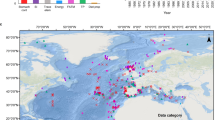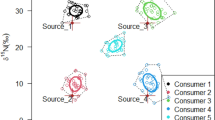Abstract
THE nitrogen pools of animals are enriched in 15N relative to their food1, with the top predators having the highest concentrations of this stable isotope2. The use of δ15N to indicate trophic position depends on the degree to which it reflects variation in the underly-ing food-web structure, rather than variable fractionation along the food chain. Here we compare adult lake trout, a top pelagic predator, from a series of lakes, and find that δ15N values vary from 7.5 to 17.5%o, a surprisingly wide range for one species. The length of the food chain can explain this variation, supporting the idea that δ15N is a food-web descriptor. Food-chain length was measured by the presence or absence of two intermediate trophic levels, pelagic forage fish and the macrozooplankter, Mysis relicta, each of which when present contributes about three δ15N units to the trout signature. We find that δ15N can be used as a continuous, integrative measure of trophic position, which is supported by its correlation to mercury levels in lake trout.
This is a preview of subscription content, access via your institution
Access options
Subscribe to this journal
Receive 51 print issues and online access
$199.00 per year
only $3.90 per issue
Buy this article
- Purchase on Springer Link
- Instant access to full article PDF
Prices may be subject to local taxes which are calculated during checkout
Similar content being viewed by others
References
Minigawa, M. & Wada, E. Geochim. cosmochim. Acta 48, 1135–1140 (1984).
Owens, N. J. P. Adv. Mar. Biol. 24, 389–451 (1987).
Peterson, B. J. & Fry, B. A. Rev. ecol. Syst. 18, 293–320 (1987).
Fry, B. Limnol. Oceanogr. 33, 1182–1190 (1988).
Kidd, K. A., Schindler, D. W., Hesslein, R. H. & Muir, D. C. G. Sci. Tot. Environ. (in the press).
Hesslein, R. H., Capel, M. J., Fox, D. E. & Hallard, K. A. Can. J. Fish. aquat. Sci. 48, 2258–2265 (1991).
Hobson, K. A. & Welch, H. E. Mar. Ecol. Progr. Ser. 84, 9–10 (1992).
Kling, G. W., Fry, B. & O'Brien, W. J. Ecology 73, 561–566 (1992).
Toda, H. & Wada, E. Hydrobiology 194, 85–90 (1990).
Estep, M. L. F. & Vigg, S. Can. J. Fish. aquat. Sci. 42, 1712–1719 (1985).
Kline, T. C. Jr, Goering, J. J., Mathisen, O. A., Poe, P. H. & Parker, P. L. Can. J. Fish. aquat. Sci. 47, 136–144 (1990).
Dadswell, M. J. Distribution, Ecology, and Postglacial Dispersal in Certain Crustaceans and Fishes in Eastern North America (National Museum of Canada, Ottawa, 1975).
Lasenby, D. C., Northcote, T. G. & Furst, M. Can. J. Fish. aquat. Sci. 43, 1277–1284 (1986).
Martinez, P. J. & Bergersen, E. P. N. Am. J. Fish. Manage 9, 1–11 (1989).
Evans, D. O. & Loftus, D. H. Can. J. Fish. aquat. Sci. 44 (suppl. 2), 249–266 (1987).
Martin, N. V. J. Fish. Res. Board Can. 11, 5–10 (1954).
Trippel, E. A. & Beamish, W. H. Can. J. Fish. aquat. Sci. 50, 1442–1455 (1993).
Rasmussen, J. B., Rowan, D. J., Lean, D. R. S. & Carey, J. H. Can. J. Fish. aquat. Sci. 47, 2030–2038 (1990).
Cabana, G., Tremblay, A., Kalff, J. & Rasmussen, J. B. Can J. Fish. aquat. Sci. 51, 381–389 (1994).
Thomann, R. W. Can. J. Fish. aguat. Sci. 38, 280–296 (1981).
Hairston, N. G. Jr & Hairston, N. G. Am. Nat. 142, 379–411 (1993).
Spiller, D. A. & Schoener, T. W. Nature 347, 469–471 (1990).
Power, M. E. Ecology 73, 733–746 (1992).
Diehl, S. Oikos 68, 151–157 (1993).
Pimm, S. L. Food Webs (Chapman and Hall, London, 1987).
Pimm, S. L. & Lawton, J. H. Nature 275, 542–544 (1978).
Pimm, S. L. & Lawton, J. H. Nature 268, 329–331 (1977).
Konkle, B. R. & Sprules, W. G. Trans. Am. Fish. Soc. 115, 515–521 (1986).
Author information
Authors and Affiliations
Rights and permissions
About this article
Cite this article
Cabana, G., Rasmussen, J. Modelling food chain structure and contaminant bioaccumulation using stable nitrogen isotopes. Nature 372, 255–257 (1994). https://doi.org/10.1038/372255a0
Received:
Accepted:
Issue Date:
DOI: https://doi.org/10.1038/372255a0
This article is cited by
-
Trophic transfer of polycyclic aromatic hydrocarbons through the food web of the Fildes Peninsula, Antarctica
Environmental Science and Pollution Research (2023)
-
Stable Isotopes (δ13C and δ15N) and Trace Elements of Invertebrates and Fish from the Coastal Waters of Ha Tinh Province, Central Vietnam
Archives of Environmental Contamination and Toxicology (2023)
-
Exploring the partitioning of hydrophobic organic compounds between water, suspended particulate matter and diverse fish species in a German river ecosystem
Environmental Sciences Europe (2022)
-
Impact of squid predation on juvenile fish survival
Scientific Reports (2022)
-
Two Congener-specific Models Estimate PCB TEQ Hazard to American Mink (Neovison vison) Living near a Western New York Creek
Archives of Environmental Contamination and Toxicology (2022)
Comments
By submitting a comment you agree to abide by our Terms and Community Guidelines. If you find something abusive or that does not comply with our terms or guidelines please flag it as inappropriate.



